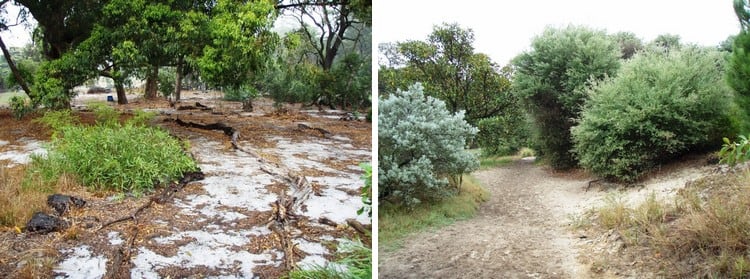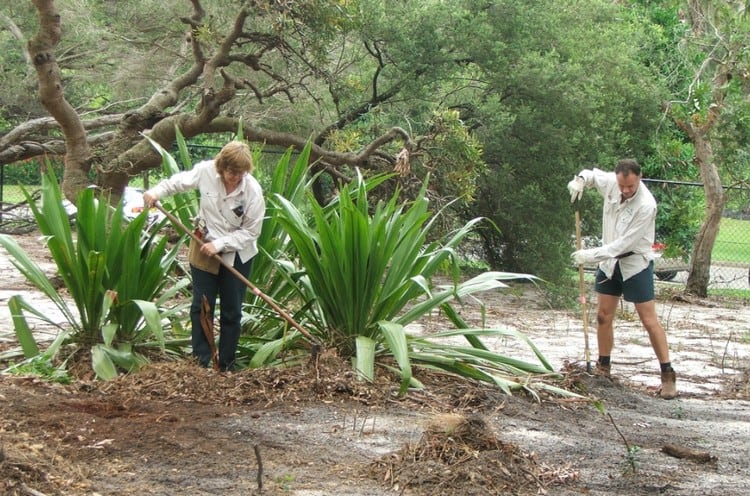You may know that Centennial Parklands is home to a range of native and exotic flora – but do you know we also conserve an endangered plant community called the Eastern Suburbs Banksia Scrub?
Not only do we conserve it, but we’re a best-practice site for its conservation!
What is Eastern Suburbs Banksia Scrub?
Eastern Suburbs Banksia Scrub is a nationally and state-listed endangered ecological scrub and heath vegetation community confined to deep, wind formed sand deposits in the coastal suburbs of Sydney. Estimates are that it originally covered over 5,300 hectares, however today there is less than 127 hectares remaining (a loss of over 97%).
We have several remnant patches of remnant Eastern Suburbs Banksia Scrub in Centennial Park, and undertake active bush regeneration work at the sites at the Bird Sanctuary in Centennial Park and adjacent York Road in Centennial Park.
 ESBS remnants in Centennial Parklands (Bird Sanctuary on right; York Road on left)
ESBS remnants in Centennial Parklands (Bird Sanctuary on right; York Road on left)
Survival threats…
The fragments of Eastern Suburbs Banksia Scrub that remain in Sydney are generally small and isolated, which inhibits the functioning of natural ecological processes.
In addition to vegetation clearing, other threats include habitat degradation resulting from increased nutrients from stormwater runoff, invasion by weed species, inappropriate fire regimes, and inappropriate access resulting in erosion and illegal rubbish dumping.
Build-up of leaf litter resulting in reduced germination of plants from the soil seed bank is also considered a threat, as are the effects of pests and disease. Grazing by European rabbits and predation by foxes and domestic animals, and infection of plants by the pathogen Phytphthora cinnamomi are also considered major threats.
Our ‘best practice’ conservation…
In 2008 Centennial Parklands was recognised as a best practice ‘Threatened Species Demonstration Site’ for our management program of Eastern Suburbs Banksia Scrub remnants. This recognised the quality work of our horticultural and bush regeneration staff, supported admirably by a dedicated and hard working team of bush regeneration volunteers.
The role of fire…
Fire is an important natural element in many native plant communities, with some species – like Eastern Suburbs Banksia Scrub – being reliant on fires of a particular intensity and frequency for regeneration.
Within urban environments, the suppression of fire can result in a loss of species diversity through the local extinction of species that typically require fire for seed germination. Fire, or ecological burning, is a standard practice we undertake as part of our species management in the Parklands, as it helps germination and maintains the floristic composition and vegetation structure of the Eastern Suburbs Banksia Scrub community.
 Volunteers are a regular sight in the Bird Sanctuary
Volunteers are a regular sight in the Bird Sanctuary
What to know more about ESBS?
Here is a great Fact Sheet (PDF) on Eastern Suburbs Banksia Scrub in the Sydney Region.
If you are a public or private landholder with remnant ESBS on your property, here is a more detailed publication that outlines the NSW Recovery Plan for the species: ESBS Listing and Recovery Plan.
For those seeking more scientific insight, here is a brief presentation on the importance of fire in Eastern Suburbs Banksia Scrub communities.
Acknowledgements
We would like to acknowledge:
- the support of the Centennial Parklands Foundation for their funding support of the ESBS maintenance program
- the dedicated and long-term work of the bush regeneration volunteers who turn up routinely, work diligently and have displayed a long-term commitment to their project – to ensure our threatened plant community is preserved.